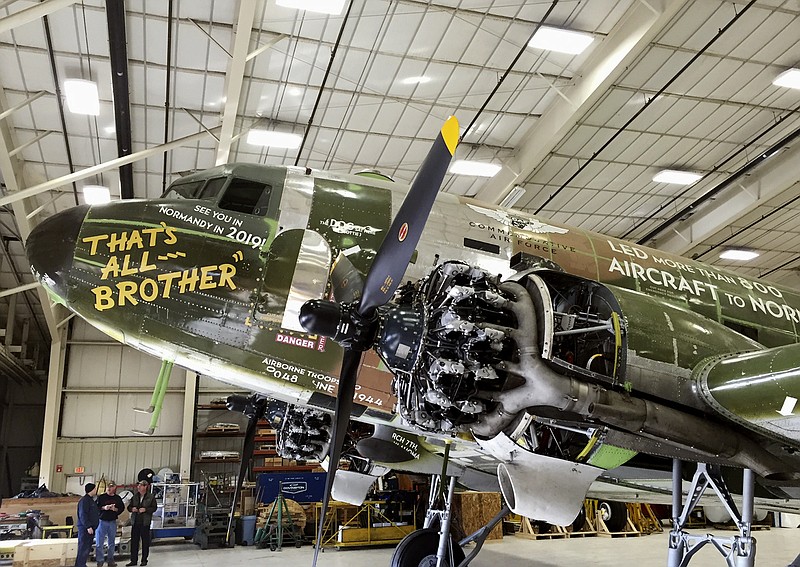It took two eagle-eyed historians to track down the plane that led hundreds of Allied aircraft into Normandy during World War II.
A few years ago, the historical treasure was languishing in an aircraft boneyard in Wisconsin.
The plane, a twin-engine C-47 called "That's All, Brother," carried American paratroopers into German-occupied France on June 6, 1944, or D-Day. It led the main formation that dropped thousands of men into what became a bloody but decisive battle, paving the way for the liberation of northern France from the Nazis.
Like many other World War II planes, "That's All, Brother" was sold for private use after the fighting ended. It cycled through a series of owners and its historical significance was in danger of being forgotten.
But in 2007, the two historians started following a paper trail.
From Normandy to Oshkosh
At the Air Force Historical Research Agency in Montgomery, Ala., Matt Scales, then a member of the Air National Guard, was researching John M. Donalson, who piloted the plane on the day it soared over the beaches of Normandy.
Scales and another historian in the Air Force Reserve, Ken Tilley, found its tail number and used it to trace the C-47's postwar path and see whether it had been dismantled. They were relieved to find that it had not.
"It's so rare to have a plane that was actually there and did what it did," Scales said in a phone interview. "This airplane has been a fighter its entire life."
The historians discovered that it had ended up in Mesa, Arizona, with a new camouflage-inspired paint job. (The pattern called to mind C-47s that had flown in the Vietnam War, but during World War II, "That's All, Brother" had stripes.)
"We were amazed to find it in Arizona and that it was for sale," Tilley said. "We immediately contacted every museum and major aircraft organization to try to save the plane, to no avail at the time."
But a couple of years later, Scales looked for the plane again and found it had been sold to a company in Oshkosh, Wisconsin, where it was in danger of being taken apart.
'A Coca-Cola Can With Wings'
During World War II, C-47s, a military version of the civilian DC-3, transported cargo and troops. "It's a rugged airplane, and a joy to fly once you're in the air," said Albert J. Parisi, an aviation writer and historian who has flown a C-47.
The planes were indispensable on D-Day, he added, even though many were shot down. "They started encountering anti-aircraft fire, and these aircraft are not armor-plated," Parisi said. "There's no protection. Think of a Coca-Cola can with wings."
Normandy was overcast on D-Day - terrible weather for the operation - but "That's All, Brother" emerged largely unscathed. The name of the plane, inspired by a song performed by Mae West, was intended as a message for Hitler.
It carried a chaplain (he was unarmed but determined to increase church attendance by parachuting into war with everyone else) and a dog (a Scottish terrier puppy that stayed on the plane and was, by all appearances, also unarmed). Both survived, and the plane made more runs over the course of the invasion before returning to the United States.
'My Jaw Kind of Hit the Floor'
After Scales discovered that the plane had made its way to Wisconsin, he contacted the new owner, Basler Turbo Conversions, to share what he knew about its history. Basler told the story to a blogger for Wittman Regional Airport in Oshkosh, who wrote posts about it in 2013 and 2014.
Those posts, in turn, were spotted by members of the Commemorative Air Force, an organization based in Dallas that collects and restores historical aircraft for flight.
Experts there, including Keegan Chetwynd, the curator, were skeptical of the story. But one day he found a National Archives video showing "That's All, Brother" about to take off for Normandy in 1944. Two minutes and 23 seconds in, he saw it: A tail number was visible in the black-and-white clip, and it matched the one on the plane in Oshkosh.
"At that point, my jaw kind of hit the floor," Chetwynd said. "I went darting down the hallway looking for the others to tell them we needed to go get the airplane."
Chetwynd was worried. For all he knew, this treasure might have already been dismantled for conversion into a more modern turboprop airplane - that, after all, is what Basler does.
He made some calls and was happy to learn "That's All, Brother" was intact and in need of a buyer.
Restoration Is Underway
In 2015, Commemorative Air Force raised hundreds of thousands of dollars in a Kickstarter campaign to buy the aircraft and begin a restoration that would retain as much of its original structure as possible.
Basler's specialists are doing the restoration because they have dismantled plenty of old C-47s and technicians had many of the parts they needed. The plane had a successful engine test in December, and Commemorative Air Force hopes to see "That's All, Brother" take flight in the coming days.
Ultimately, Chetwynd said, the goal is to fly the plane over Normandy in 2019 to mark the 75th anniversary of D-Day.
Scales said that after years of keeping tabs on the old C-47, he was glad to see its historical value realized.
"It's so cool for me that this will be another way for the story to continue to be told," he said. "It'll hopefully continue the legacy of these guys and the sacrifice they made."
